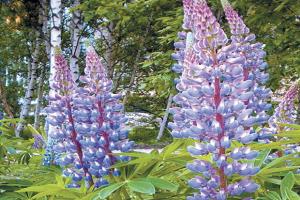Old-fashioned values wander even into the garden, it seems. An interesting tree for the garden has long, thin leaves that look strikingly similar to marijuana (Cannabis sativa) with five leaflets in each cluster. These leaves have the delicate aroma of sage.
The tree blooms late in the season when few other trees are blooming. It has striking blue-violet flowers that hang in clusters or panicles similar to lilacs or the butterfly bush. The flowers are followed by deep purple berries, and it is these berries that are the source of medicines used to treat everything from menopause to female infertility.
This charming small tree, Vitex agnus-castus, is commonly called the chaste tree. It is called chaste because concoctions once made from it treated overactive libido. Besides chaste tree, this Mediterranean native goes by many common names, including Abraham’s balm, chasteberry, lilac chastetree, and even monk’s pepper.
This is a small tree growing just 20 feet tall with a narrow spread between five and 20 feet. Many chaste trees seem to go astray later in life, and slouch into a more slovenly shape. Simply prune it back into the shape you want.
For best results, plant chaste trees in full sun to light shade. Choose a spot with well-draining soil. Keep newly planted trees well watered but not soggy. Once established, these are quite drought-tolerant trees.
Chaste trees can be used as a single specimen, planted along the driveway, or in a mixed hedge or edge of woodlands. Smaller specimens of chaste tree can be potted up as a patio tree.
There are no serious pests that attack chaste trees. To keep growth under control you may want to prune every year or two. For a single-trunk tree, cut off all trunks except one central leader. Prune in the winter when it is not actively growing. Because of its fast growth it is OK to prune heavily, and mistakes are quickly grown back.
For a multi-stemmed shrub or thicket, cut out all of the limbs in the center of the tree down to just four or five trunks. You can also treat this the same way many people treat butterfly bushes (Buddleia davidii) and just cut down the whole plant to the ground each winter.
It will shoot up in early spring and bloom the same summer, just slightly later than usual. Cut off all the blossoms as soon as they fade, and you will get a second burst of blooms even later in the season.
These hardy trees have good tolerance to salt air and high winds, so they make nice additions to the seashore landscape. They are hardy in USDA zones 6-9 and parts of Zone 5. Even if they do winter kill or die to the ground, chaste trees will often sprout and bloom the following summer.
Because they bloom late in the season, chaste trees are great bee forage plants that provide nectar when other trees are not in bloom. Besides bees, they are a favorite of hummingbirds and butterflies.
Good for hummingbirds, good for butterflies, good for late flowers - seems that goodness sometimes calls for even the trees to be chaste.



















































